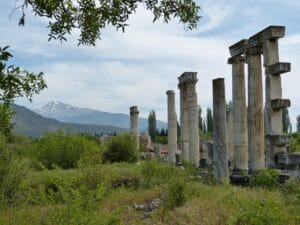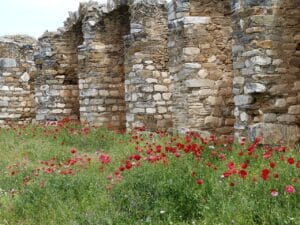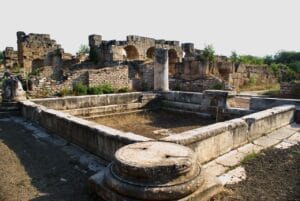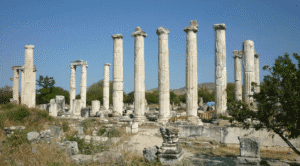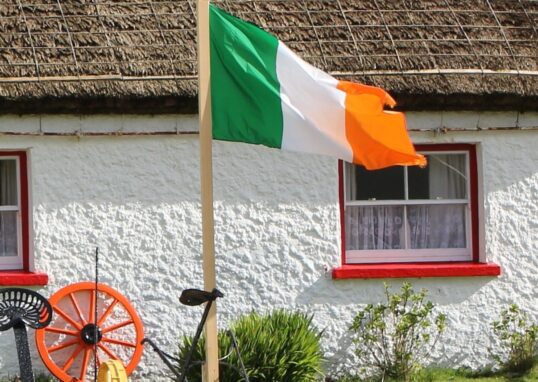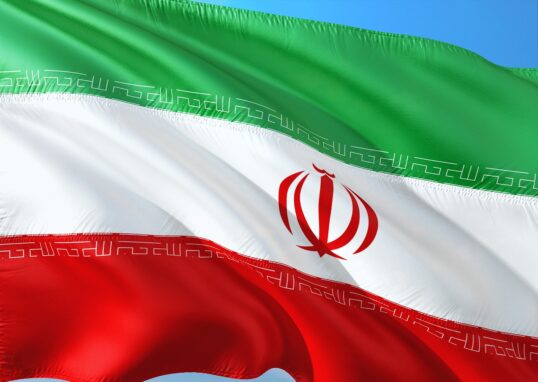
Aphrodisias – The Ancient City of Love and Art
Aphrodisias is arguably the most beautiful and respectful ancient city in the world. It lies in modern Turkey, in western Anatolia’s Aydın province. The city was consecrated in Aphrodite’s memory, the Greek goddess of love, beauty, and fertility. It was a sacred place, a cultural center, and a residence of artists’, sculptors’, and philosophers’ for a few centuries. In this complete tour guide, we will talk about Aphrodisias thoroughly. We will explain its history, architecture, culture, and importance in ancient times. We will look at the remaining things today and how individuals from different parts of the world tour it. Finally, we will see the nearby places that make the trip to Aphrodisias more meaningful. This article is written in short sentences, simple words, and easy transitions, so that you can enjoy and understand the story of Aphrodisias to its every detail.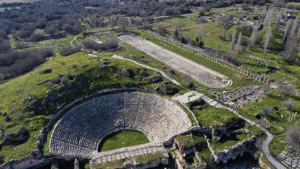
The Location of Aphrodisias
Aphrodisias lies in Turkey’s Meander Valley. The valley is famous for its rich soil and beautiful landscapes. The city was founded near the small village of Geyre. It is about 100 kilometers east of today’s Denizli town. The region includes mountains, rivers, and plains. The Meander River flows nearby. The region was long supplied with marble. The commodity enabled Aphrodisias to be a leading centre for sculpture. Marble quarries were just a short walk outside of the city. The location of Aphrodisias was also strategically located. It was along trade routes. Merchants, pilgrims, and travelers frequented the city. This made Aphrodisias a cosmopolitan and connected city in the ancient period.
The Goddess Aphrodite
Aphrodite was the goddess of worship at the center of Aphrodisias. She was among the favorite goddesses of ancient Greek mythology. She represented love, beauty, and fertility. The people believed their city was uniquely favored by the goddess. The most prominent shrine was the Temple of Aphrodite. Pilgrims from all over the world came to worship her. Festivals, offerings, and celebration were made in her name. Later, when the Roman Empire stretched across the region, Aphrodite’s cult became more important. Roman emperors patronized the city, as it had a special connection to their own mythology of Venus, the Roman equivalent of Aphrodite.
The Early History of Aphrodisias
Aphrodisias was settled as far back as in the Bronze Age. However, the city flourished during the Hellenistic era (around 3rd century BCE). During this time, Greek culture pervaded far and wide due to the conquests of Alexander the Great. The city was officially founded during the 2nd century BCE. It was designed with wide streets, public monuments, and beautiful buildings. The temple of Aphrodite was at the center of life. When the Romans came to Anatolia, they were amazed at the city’s devotion to Aphrodite. Even the Roman Senate granted unusual privileges to Aphrodisias, such as exemption from taxation. This rendered the city wealthy and affluent.
The Golden Age of Aphrodisias
The golden period of Aphrodisias was the Roman Imperial period. From the 1st century BCE to the 3rd century CE, the city prospered.
Art and Sculpture
Aphrodisias was renowned across the globe for sculpture. Aphrodisian sculptors were the best artists in the empire. Marble quarried locally was pure and strong. Sculptors fashioned statues of the citizens, emperors, and gods. The statues were sold in Rome and other cities.
Education and Philosophy
The city was also renowned for education. It had schools of rhetoric and philosophy. Scholars traveled to acquire language, science, and art. Aphrodisias was a cultural center, not a religious one.
Political Significance
Because it was connected with Aphrodite, Aphrodisias stood in a special place in the Roman world. Politicians like Julius Caesar and Augustus held the city in high esteem. Roman authorities gave it funds to build magnificent monuments.
Main Monuments of Aphrodisias
When we visit Aphrodisias today, we are able to locate many ruins that bear evidence of how grand it once was.
Temple of Aphrodite
It was the heart of the city. It was built in the 1st century BCE. The temple had tall columns and a sacred altar. Later, under the Christian period, the temple was utilized as a church.
The Stadium
Among the best-preserved stadiums in the old world is to be found here. It would have held some 30,000 people. It was used for athletic contests, festivals, and gladiator combat.
The Theater
The theater of the city was built into a hillside. It had a seating capacity of 8,000. Plays, oratory, and ceremonies were staged here.
The Sebasteion
This was a beautiful complex in the emperor’s and Aphrodite’s honor. It had reliefs with myths, gods, and emperors. It symbolized the union between divine power and Roman rule.
The Agora
The agora, or market, was the commercial hub. It had shops, workshops, and fountains surrounding the square. It was never still with activity.
Baths and Pools
Like in other Roman cities, Aphrodisias too had large bath complexes. People went not only to bathe but to socialize and relax.
The Decline of Aphrodisias
The glory of the city began to decline in the later Roman period. There were numerous reasons why it declined:
- Earthquakes collapsed buildings and monuments. Economic difficulties in the Roman Empire reduced patronage.
- Christianity became more accepted and the cult of Aphrodite no longer important. The city was invaded in the early medieval period.
By the 12th century, Aphrodisias was mostly deserted. A village called Geyre was built on its ruins in the locality.
Rediscovery and Excavations
Aphrodisias was rediscovered by travelers and scholars in the contemporary world. European travelers reported the ruins in the 18th and 19th centuries. Mass excavations were undertaken in the 20th century, mainly by the Turkish archaeologist Kenan Erim. His excavations unearthed the stadium, the Sebasteion, as well as many sculptures. Aphrodisias today is a UNESCO World Heritage Site.
The Aphrodisias Museum
In addition to the ruins, there is a museum which houses the best artifacts. Statue of gods, philosophers, athletes, and emperors can be seen. Marble reliefs from the Sebasteion are also kept here. The museum tells us how skillful the Aphrodisias sculptors were. It’s one of Turkey’s finest archaeological museums.
Aphrodisias Today
Tourists visit Aphrodisias today. They can walk among the ruins, tour the stadium, and stand in the theater. The peaceful countryside adds to it. The site is less crowded than places like Ephesus, so it is calmer. The city is also a city of learning. Students and researchers from across the world come to study the art and architecture of Aphrodisias.
Surrounding Places Near Aphrodisias
Aphrodisias is a quaint old city. It is located in western Turkey, in the Aydın province. The ruins are full of history, art, and culture. But the fun does not stop there. There are a number of other amazing sites near Aphrodisias. Some are natural sites, and others are ancient cities. Together, they make the region one of Turkey’s wealthiest.
Pamukkale and Hierapolis
Pamukkale – The Cotton Castle
Pamukkale is Turkey’s greatest natural wonder. It is 100 kilometers from Aphrodisias. Pamukkale is referred to as the “cotton castle.” As soon as you see it, you’ll understand why. White calcium terraces form on the side of a hill. Hot spring water cascades over them. The result looks like a shining castle of cotton and snow. Visitors can walk barefoot over the terraces. The warm water flows over their feet. Others believe the waters to be healing. The view is also breathtaking, especially at sunset.
Hierapolis – The Holy City
To one side of Pamukkale lies Hierapolis, the ancient city. The kings of Pergamon built it in the 2nd century BCE. It was later absorbed into the Roman Empire. The town boasts a big theater, streets, temples, and baths. It was also famous as a healing center. Individuals traveled to bathe in the hot springs for their well-being. The Necropolis (city of the dead) is enormous. It shows how influential Hierapolis used to be in the past.
Denizli
Denizli is the nearest big city to Aphrodisias. Denizli is a modern town, with a lot of dynamism. Denizli is renowned for textiles. There are plenty of factories that produce cotton, towels, and clothing. Denizli is often called the “textile capital of Turkey.”
The city also has cultural events:
- Denizli Atatürk Museum: A former house in which Atatürk slept. Laodicea on the Lycus: A very old city near Denizli with theaters, temples, and colonnaded avenues. It was included among the Seven Churches of Asia in the Bible.
- Denizli Cable Car and Bağbaşı Plateau: It is possible to take a cable car to the plateau with fresh air, woods, and restaurants.
Denizli is the major gateway to Pamukkale. Plenty of tourists stay here before going out to the nearby attractions.
Ephesus
Ephesus is among the best ancient cities in the world. It is about 170 kilometers west of Aphrodisias, near the town of Selçuk.
The Ancient City
There once existed a magnificent Greek and Roman city named Ephesus. It had over 200,000 residents. It was famous for trade, culture, and religion. Walking into Ephesus today is stepping back into history.
Main highlights are:
- Library of Celsus: Elegant marble building that contained thousands of scrolls.
- Theater: Massive building which seated 25,000 people. Plays, speeches, and gladiator combat were held here.
- Temple of Artemis: The Seven Wonders of the Ancient World. Some columns are still standing today, but its legend lives on.
- Terrace Houses: Luxury homes with mosaics and frescoes, showing how rich folks lived.
Christian Heritage
Ephesus is important to Christians, too. The House of the Virgin Mary, where Mary allegedly spent her last days, is nearby. The Basilica of St. John, built by Emperor Justinian, is atop the tomb of the apostle John.
Miletus
Miletus is referred to south of Ephesus and close to the Aegean Sea referred to as near. It is another large ancient city. Miletus was a major city of science and philosophy. Philosophers like Thales, Anaximander, and Anaximenes were native to this city. They were some of the earliest scholars to appreciate learning nature and the universe in a scientific way.
Key Highlights
- Theater: A gigantic structure where 15,000 individuals can accommodate.
- Delphinion: A temple dedicated to Apollo Delphinios.
- Baths of Faustina: Built in memory of a Roman empress.
Miletus was also a busy port city. But, at some point, the harbor clogged up, and the town went into decline.
Didyma
Near Miletus is Didyma. It was not a fully developed city but a sanctuary. It had the Temple of Apollo, which was among the largest in the ancient world. People went to Didyma to witness the oracle of Apollo. Priests gave answers and predictions here, as did the priests at Delphi in Greece. The temple was gigantic, with towering pillars, although it never got finished. Today, visitors get to walk among its gigantic remains. The atmosphere is still mysterious.
Priene
Priene is an Ionian town near the sea. It was not as big as Ephesus or Miletus but famous for its planning. It was built on a grid system, with broad avenues and blocks. This made Priene a standard city of ancient times.
Highlights:
- Temple of Athena Polias: Built by the famous architect Pytheos.
- Theater: Small and elegant, seating 5,000 people.
- Agora: The city’s public square.
Priene sits atop a hillside. Below lies the Meander Valley, with marvelous scenery.
Bodrum (Ancient Halicarnassus)
Bodrum is a tourist resort town on the Aegean coast now. It lies about 180 kilometers from Aphrodisias. Nowadays, it is famous for beaches, nightlife, and yachts. But once, it was Halicarnassus. Halicarnassus was the site of the Mausoleum of Halicarnassus, one of the Seven Ancient Wonders of the World. It was a mausoleum built for King Mausolus by his wife Artemisia. Though destroyed by earthquakes, parts still exist.
Bodrum has:
- Bodrum Castle: Built by the Knights of St. John during the 15th century. Nowadays, it houses the Museum of Underwater Archaeology.
- Amphitheater: A well-restored building with great views of town and sea.
Bodrum is lively and modern but still maintains its link to ancient times.
Aydın
Aydın is the provincial town near Aphrodisias. It’s not a big tourist town, but it is attractive locally. The town has bazaars, cafes, and Ottoman houses.
Nearby are other ancient sites including:
- Tralles: An old Hellenistic and Roman city, with remains of arches and aqueducts.
- Magnesia on the Maeander: Another ancient town with theater, agora, and temples.
Aydın is an adequate stop for tourists who want to see everyday Turkish life.
Selçuk and Şirince
Selçuk
Selçuk is the gateway to Ephesus. But it has other attractions as well:
- Isa Bey Mosque: A 14th-century mosque with elegant stonework. Ayasuluk Hill: Site of the Byzantine castle and Basilica of St. John.
Şirince
Not too far from Selçuk is the small village of Şirince. It’s famous for its stone-houses, cobblestone streets, and viniculture. There are fruit wines, olive oil, and Turkish food prepared by the villagers for the tourists to savor. It is a small, peaceful area.
Lake Bafa and Its Surroundings
Lake Bafa lies between Priene and Miletus. It used to be a bay of the Aegean Sea. The river finally filled it with silt and turned it into a lake. The lake is being encircled by hills, olive groves, and ancient sites. There are monasteries, Byzantine churches, and rock paintings along its shores. It is great for hiking, bird watching, and photography.
Other Notable Sites
- Nysa: A local ancient city to Sultanhisar, with a theater, stadium, and library. It was a school.
- Alinda: This city, close to Karpuzlu, has well-preserved walls and towers.
- Aphrodisias Museum (situated adjacent itself): The majority of visitors, when leaving the site, pair the ruins with the museum that houses the sculptures.
Why These Surroundings Matter
The landscape around Aphrodisias is full of history. From the Pamukkale’s white terraces to Ephesus’s grand ruins, from Bodrum’s busy harbor to serene villages like Şirince, every place adds to the richness. Visiting Aphrodisias on your own is excellent. But visiting surrounding sites offers the full picture of ancient Anatolia. It shows how cities, cultures, and empires expanded and were ruined. It also shows the harmony between nature and history. Aphrodisias landscape is a map of treasures.
- Every stop is unique: Pamukkale and Hierapolis show the glory of nature and medicine. Denizli and Aydın offer modern life with an element of history.
- Ephesus, Miletus, Priene, and Didyma show the splendor of ancient Greek and Roman towns. Bodrum offers the sparkle of the sea and the memory of wonders.
Small villages and lakes offer peace and charm. Together, these sites make a trip rich and rewarding. Aphrodisias is the hub, but the lands surrounding it are the wings that make the trip soar.
Conclusion
Aphrodisias really is a city of love and art. It was bestowed with marble, belief, and geniuses. For centuries, it was a shining cultural center in Anatolia. And now their ruins continue to speak. They speak to us of emperors and gods, artists and pilgrims, festivals and daily life. A trip to Aphrodisias is more than a trip to the past. It is a chance to experience the sense of beauty, love, and history which once inhabited the city’s streets. And when combined with nearby wonders of Pamukkale, Ephesus, and Bodrum, the journey becomes unforgettable.

